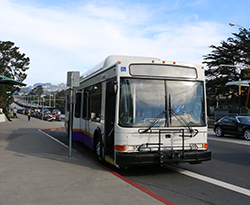Campus shuttle system improved with bigger, better buses
The thousands of users of SF State's free shuttle service can expect improved commutes this semester as a new fleet of more eco-friendly buses make for shorter waits.

Larger, more eco-friendly shuttle buses have been introduced at SF State this semester.
On Jan. 26, SF State introduced buses that are significantly larger, at 35 and 40 feet with a capacity of more than 60, as compared to the 28-foot buses carrying 38 riders that were in use until this semester. transMETRO, a full-service shuttle company, now operates the fleet of five buses between campus and Daly City BART, with an estimated maximum wait time of 10 minutes between buses.
"It's a major step forward, a systemic change," said Wendy Bloom, director of campus planning and co-chair of the transportation committee. "We're better serving students."
With both front and rear doors, as opposed to the single door on the old shuttles, passengers can enter and exit the new buses at the same time, speeding up the boarding process. Another improvement is better accessibility for passengers who use wheelchairs. The new buses are lower to the ground and allow for faster boarding, which Bloom hopes will encourage increased ridership among wheelchair users.
The fleet of refurbished buses is also more environmentally friendly, running on compressed natural gas, which remains clear and odorless as it burns. The old shuttles, which used standard unleaded fuel, got only three to four miles per gallon.
The shuttle service transports approximately 6,000 riders each weekday between campus and Daly City BART, Bloom said. One of those riders is Herman Brown, a senior double majoring in art history and studio art, who tested out a new bus on the morning of the launch. "I'm excited the school finally got this upgraded equipment so we won't have those 20 minute waits," Brown said. "I'm enjoying it."
The improved shuttle service is part of SF State's efforts to reduce its environmental impact and diminish congestion around campus by encouraging commuters to use public transit. A transportation survey completed in August 2014 showed that these efforts are increasingly successful. Forty-seven percent of commuters used Muni for some portion of their trip to campus while 26 percent used BART, an increase of 22 and 19 percent, respectively, since 2008.
The number of commuters driving alone to the University decreased by 32 percent over the same time period, with about 20 percent of campus commuters driving alone to campus in 2014 as compared to 26 percent in 2008.
Updating the bus fleet has been in the pipeline for several years. Long lines have been a continued complaint among riders, who number almost 350 per hour at peak times, according to a 2013 study. The maintenance costs for the aging shuttle fleet were also a growing problem, reaching $150,000 in their final year of use, said Patricia Tolar, transportation coordinator.
Initially, the transportation committee considered purchasing new buses, but the cost of the shuttles, as well as the prospect of having to remodel the Corporation Yard to house larger buses, held up the process, Bloom said. In the meantime, with many Bay Area tech companies launching shuttle services for their employees, companies began to offer the type of service the University required at a price that made the option feasible.
The cost of operating the new fleet will remain roughly the same as it was prior to the change, Tolar said. And by contracting the entire operation to an outside company, SF State will have a fixed cost rather than facing the unreliability that comes with operating the system on its own, such as unexpected maintenance expenses or payroll for substitute drivers.
The primary source of funding for the shuttle program continues to be revenue collected from campus parking fines and citations. The shuttle service will remain free of charge, with no plans to institute fees in the short- or long-term future, Bloom said.
As part of the shuttle service upgrade, SF State also revamped its boarding area at Daly City BART to make the space accessible to the larger buses.
While the 28 and 28L bus lines effectively operate along the same route as the campus shuttle, service on the 28 can take longer. And some BART commuters have reported being mistakenly charged the full Muni fare of $2.25 even though a transfer bus ride is supposed to be free.
Some commuters also prefer the SF State shuttle because of its friendly atmosphere, Bloom said. Riders may be happy to know that many of the shuttle drivers, who they have come to know and like, have stayed on with the new company, she added.
"The drivers are incredible, the best emissaries for the University," Bloom said. "There is a very appreciative, positive atmosphere. People feel taken care of."
A shuttle from SF State's old fleet will continue to be used for the campus loop service. The retired shuttles will remain on campus for special events and sports team trips, allowing the University to meet needs that it previously could not, Tolar said.
The route between campus and Daly City BART will have one minor alteration to avoid a U-turn on Winston Drive due to the buses' larger size. The duration of the ride is expected to remain the same.
A GPS-tracking app shows the locations of SF State shuttle buses. Download the "Fleetmatics Reveal" app on your smartphone and access SF State shuttle information with the username "sfsu@transmetro.org" and password "welcomesfsu." Information can also be found here: http://us.fleetmatics.com/Login.aspx?ReturnUrl=%2f